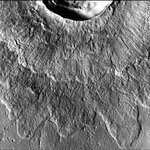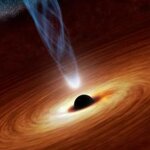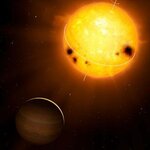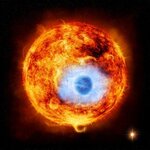Space

There is a possible new explanation for a mysterious type of crater on the surface on Mars. Double-layered ejecta craters (DLEs) are surrounded by debris excavated by an impactor just like other craters. What makes DLEs different is that the debris forms two distinct layers — a large outer layer with a smaller inner layer sitting on top. These distinctive craters were first documented in data returned from the Viking missions to Mars in the 1970s, and scientists have been trying ever since to figure out how the double-layer pattern forms.
A new study suggests that DLEs are the…

The intensity of the jets of water ice and organic particles that shoot out from Enceladus, a moon orbiting Saturn, depends on its proximity to the ringed planet, according to data obtained by NASA's Cassini spacecraft.
The finding adds to evidence that a liquid water reservoir or ocean lurks under the icy surface of the moon. This is the first clear observation the bright plume emanating from Enceladus' south pole varies predictably.
Cassini, which has been orbiting Saturn since 2004, discovered the jets that form the plume in 2005. The water ice and organic particles spray out from…

A color image, taken on May 1st, 2013 by the Wide Angle Camera (WAC) instrument aboard NASA's MESSENGER spacecraft orbiting Mercury, features the Hovnatanian crater, named for Armenian painter Hakop Hovnatanian.
The crater's elliptical shape and the bright rays' butterfly pattern indicate that a very oblique impact produced the crater. The brightness of the rays indicate that they are relatively young features on Mercury's surface.
This image was acquired as a targeted high-resolution 11-color image set. Acquiring 11-color targets is a new campaign that began in March, 2013 and that…

In this Hubble Space Telescope composite image taken in April 2013, the sun-approaching Comet ISON floats against a seemingly infinite backdrop of numerous galaxies and a handful of foreground stars.
The icy visitor, with its long gossamer tail, appears to be swimming like a tadpole through a deep pond of celestial wonders.
In reality, the comet is much, much closer. The nearest star to the Sun is over 60,000 times farther away, and the nearest large galaxy to the Milky Way is over thirty billion times more distant.
These vast dimensions are lost in this deep space Hubble exposure that…

When some galaxies stop forming new stars, they become "quenched".
Quenched galaxies in the distant past appear to be much smaller than the quenched galaxies in the Universe today, which is something of a science mystery; how can these galaxies grow if they are no longer forming stars?
Hubble COSMOS survey results may have delivered a surprisingly simple answer to this long-standing cosmic riddle.
Small, snuffed-out galaxies were thought to grow into the larger quenched galaxies we see nearby, they were thought to grow by colliding and merging with other smaller quenched galaxies some five…

Astronomers have found a new way of measuring the spin in supermassive black holes. By viewing optical, ultra-violet and soft x-rays generated by heat as the black hole fed, they were able to measure how far the disc was from the black hole.
Black holes lie at the centers of almost all galaxies, and can spit out incredibly hot particles at high energies that prevent intergalactic gases from cooling and forming new stars in the outer galaxy. Scientists don't yet understand why the jets are ejected into space, but some believe that their power could be linked to the spin of the…

Researchers have devised a way to measure the internal properties of stars, a method that offers more accurate assessments of their orbiting planets.
The astronomers examined HD 52265, a star nearly 20 percent more massive than our Sun
that is approximately 92 light years away. More than a decade ago, scientists identified an exopanet in the star's orbit. HD 52265 became an ideal model for both measuring stars' properties and how such properties can shed light on planetary systems.
Previously, scientists inferred stars' properties, such as radius, mass, and age, by…

A computer model estimate says it might be easier than previously thought for a planet to overheat into the scorchingly uninhabitable "runaway greenhouse" stage. That may mean some planets thought to be habitable right now actually are not.
In such a runaway greenhouse stage, a planet absorbs more solar energy than it can give off to retain equilibrium. As a result, the world overheats, boiling its oceans and filling its atmosphere with steam, which leaves the planet glowing-hot and forever uninhabitable, as Venus is now. One estimate of the inner edge of a star's "habitable zone" is…

Exoplanets - planets around stars other than the sun - were discovered almost 20 years ago,but for the first time, X-ray observations have detected an exoplanet passing in front of its parent star.
An advantageous alignment of a planet and its parent star in the system HD 189733, 63 light-years from Earth, has enabled NASA's Chandra X-ray Observatory and the European Space Agency's XMM Newton Observatory to observe a dip in X-ray intensity as the planet transited the star.
The planet, known as HD 189733b, is a hot Jupiter, meaning it is similar in size to Jupiter in our solar system but in…

Astronomers have long assumed a kind of cosmic equilibrium: when a galaxy produces too many stars too quickly, it greatly reduces its capacity for producing stars in the future.
A group of astronomers were able to obtain the first detailed images of this type of self-limiting galactic behavior: an outflow of molecular gas, the raw material needed for star formation that is coming from star-forming regions in the Sculptor Galaxy, NGC 253. The observations were made with the newly commissioned telescope array ALMA in Chile.
Galaxies – systems that contain up to hundreds of billions of stars,…